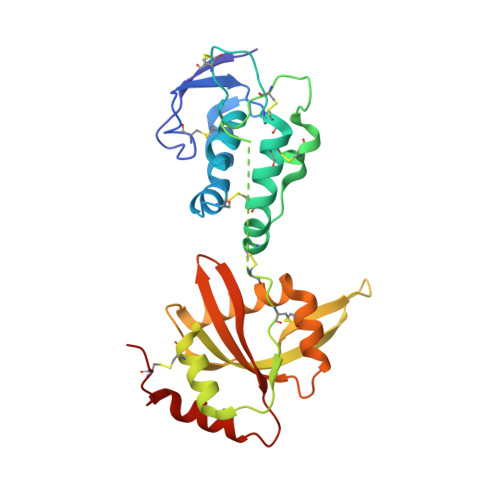The crystal structure of full-length Sizzled from Xenopus laevis yields insights into Wnt-antagonistic function of secreted Frizzled-related proteins
Bu, Q., Li, Z., Zhang, J., Xu, F., Liu, J., Liu, H.(2017) J Biol Chem 292: 16055-16069
- PubMed: 28808056
- DOI: https://doi.org/10.1074/jbc.M117.791756
- Primary Citation of Related Structures:
5XGP - PubMed Abstract:
The Wnt-signaling pathway is crucial to cell proliferation, differentiation, and migration. The secreted Frizzled-related proteins (sFRPs) represent the largest family of secreted Wnt inhibitors. However, their function in antagonizing Wnt signaling has remained somewhat controversial. Here, we report the crystal structure of Sizzled from Xenopus laevis , the first full-length structure of an sFRP. Tethered by an inter-domain disulfide bond and a linker, the N-terminal cysteine-rich domain (CRD) and the C-terminal netrin-like domain (NTR) of Sizzled are arranged in a tandem fashion, with the NTR domain occluding the groove of CRD for Wnt accessibility. A Dual-Luciferase assay demonstrated that removing the NTR domain and replacing the CRD groove residues His-116 and His-118 with aromatic residues may significantly enhance antagonistic function of Sizzled in inhibiting Wnt3A signaling. Sizzled is a monomer in solution, and Sizzled CRD exhibited different packing in the crystal, suggesting that sFRPs do not have a conserved CRD dimerization mode. Distinct from the canonical NTR domain, the Sizzled NTR adopts a novel α/β folding with two perpendicular helices facing the central mixed β-sheet. The subgroup of human sFRP1/2/5 and Sizzled should have a similar NTR domain that features a highly positively charged region, opposite the NTR-CRD interface, suggesting that the NTR domain in human sFRPs, at least sFRP1/2/5, is unlikely to bind to Wnt but is likely involved in biphasic Wnt signaling modulation. In summary, the Sizzled structure provides the first insights into how the CRD and the NTR domains relate to each other for modulating Wnt-antagonistic function of sFRPs.
Organizational Affiliation:
From the State Key Laboratory of Natural and Biomimetic Drugs and.
















